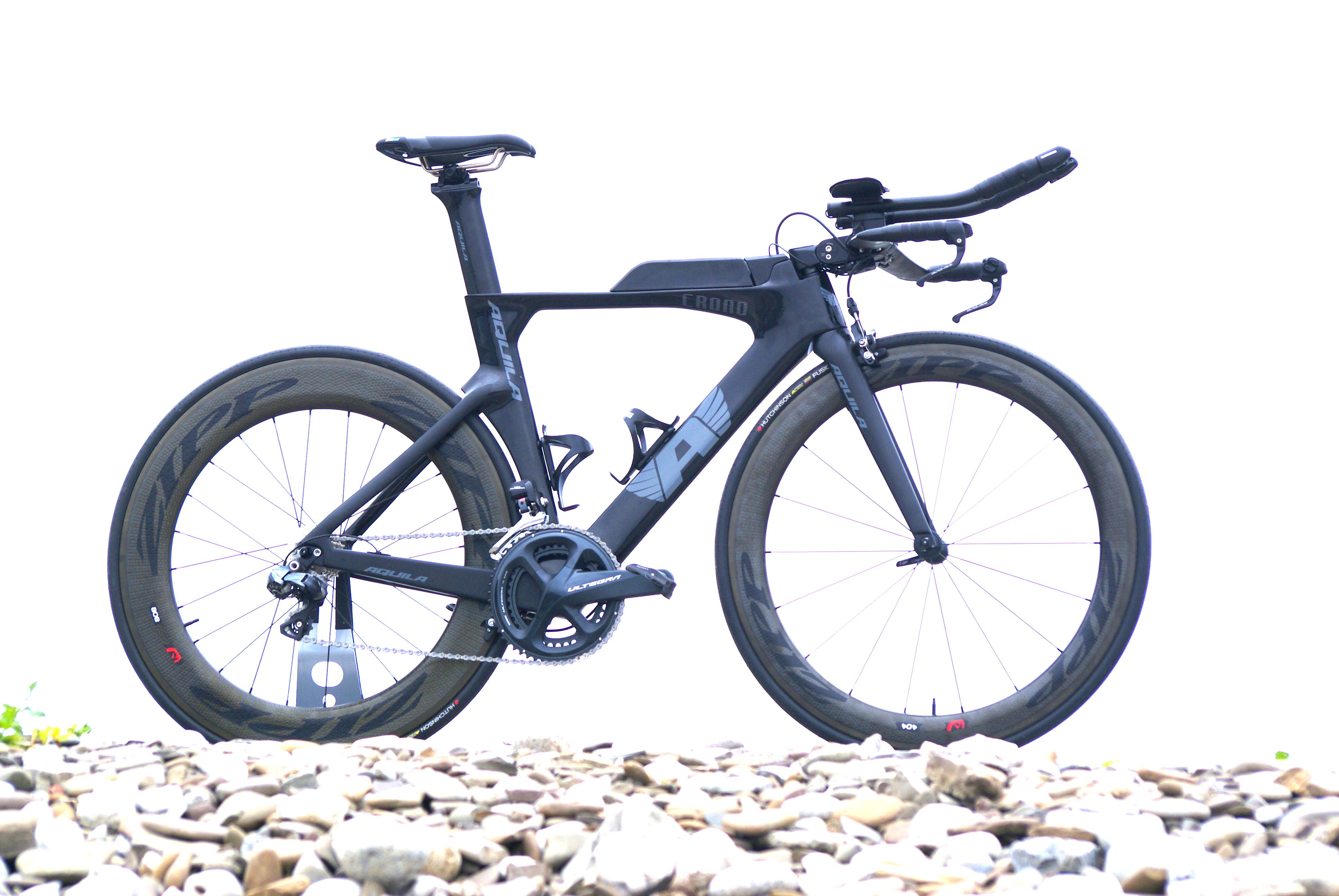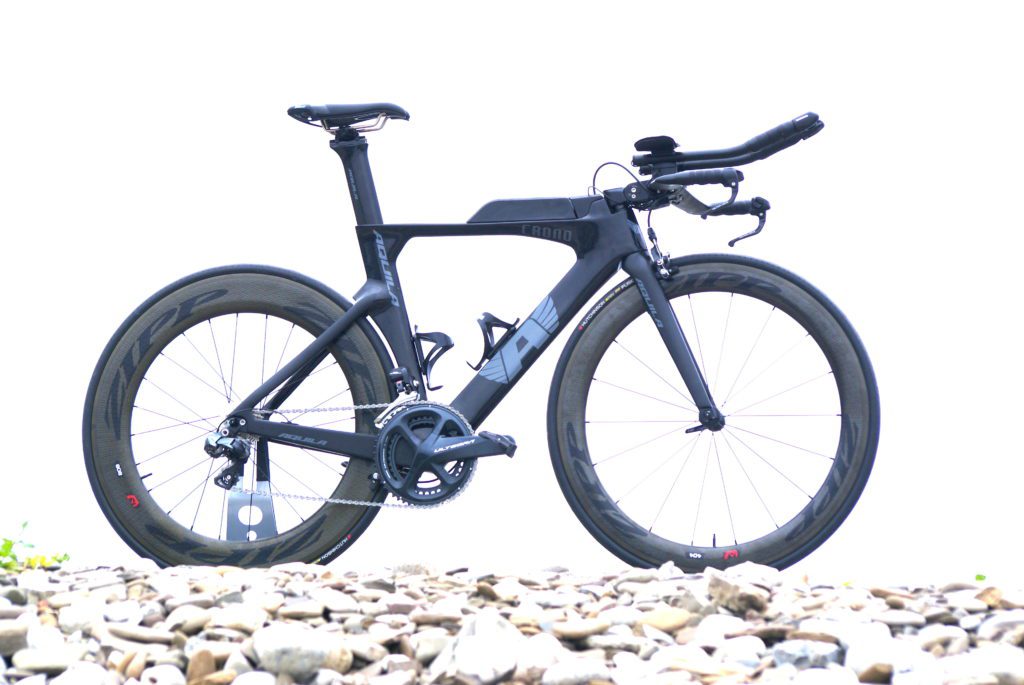The Aquila Crono and its aero value
Last year, Aquila decided it was time to step back into the triathlon world and released the new Crono.

Based in Toronto, Aquila Bicycles started out as a house brand sold through a bike store called Racer Sportif. Through the 90s the brand was popular amongst Ontario triathletes and also enjoyed some high-profile success: Lori Bowden rode an Aquila early on in her career and Sharon Donnely was on an Aquila when she won the 1999 Pan Am Games triathlon. (In the interests of full disclosure, Racer Sportif was one of my first sponsors when I turned professional in 1985 and my daughter and sons have been sponsored by Aquila for both cycling and triathlon.)
A few years ago the company decided to move beyond its “house brand” status and looked to enhance its position in the Canadian market. Aquila sponsored Team Race Clean and the Canadian U23 National Team, providing the riders with its Equipe R frames. My son, Sean Mackinnon, rode an Aquila prototype to a bronze medal at the Pan Am Games Time Trial in 2015.
Sean had to use a prototype for the TT at the games because Aquila hadn’t revamped the Crono, which debuted in the lineup, since 2010, choosing at that time to step back from the hyper-competitive triathlon market and focus on road bikes.
Last year, though, Aquila decided it was time to step back into the triathlon world and released the new Crono. Incorporating many of the features seen in the bronze-medal winning prototype, the new Crono also featured some innovative new additions that make it an interesting addition to the current crop of triathlon bikes on the market. I had a chance to ride the new Aquila Crono last summer – I took the bike for a three-week trip to Europe – and was impressed. The bike has a lot going for it and, for the money, offers excellent value.

Models
There are four different versions of the Aquila Crono. I rode a version of the Crono Ultegra R8050, which featured Ultegra Di2 and Zipp 404/ 808 Firecrest wheels ($6,500). There are a couple of versions available for $3,700 – one features Shimano’s mechanical Ultegra gruppo, while the other offers a combination of Ultegra Di2 and 105 components. There’s also a version with Shimano’s 105 components that goes for $2,999.
Frame
One of the things that I loved about the original Crono was the seat tube angle. Most triathlon bikes are designed with a seat tube angle of 78 degrees (road bikes feature seat tube angles of 72 to 74 degrees). The steeper seat tube angles put you quite far forward on your aero bars, ensuring a comfortable and powerful position for riding in an aero tuck. That position, though, isn’t great for other types of riding – for example, climbing. I’ve always liked to ride just one bike rather than switch back and forth between different bikes for different conditions, so the Crono allowed me more leeway. The more relaxed seat tube angle made the bike a bit more climbing friendly, perfect for climb-fest trips to France. Austria or Lanzarote. The seat tube angle, though, was still steep enough to allow me to get into a comfortable aero position for flat, fast rides requiring lots of time down on the tri bars. The new Crono maintains that 76-degree seat tube angle and features a new aero tube set that is optimized for performance and speed. The beefy downtube and bottom bracket provide excellent power transfer, but the overall feel on the bike remains very comfortable – this latest version of the Crono is just as stiff as the old version, but absorbs road shock considerably better than its predecessor. This was one of the best features of the Equipe R, which has been duplicated in the Crono.
Cockpit
Position is everything when it comes to fast times on a triathlon bike and the Crono frames offer a full carbon cockpit with lots of adjustment options, so you should be able to dial in the perfect fit. While I loved the base bar that is extremely stiff and perfect for climbing, I found the Aquila stem to be a bit “fiddly” and a bit of a challenge to adjust. The entire system all fits together nicely, though, and it’s easy to break down to get into a bike case, which is a huge selling point for me.
Components
As a long-time SRAM user, I was keen to try the Ultegra Di2 components and, was more than a little impressed with the performance. The Ultegra shifters were rock solid, and I found the crankset offered excellent performance, too. You really feel like all your energy goes into moving you forward. There’s a reason Zipp’s 404/ 808 combination is so popular on the triathlon circuit – the wheels are aero, comfortable and, thanks to the shallower front wheel, aren’t as susceptible to crosswinds, too.
While the Crono doesn’t offer any slick compartments, there is a custom bento box on the top tube that provides storage for gels, bars or other food you might want to take along for the ride. It’s pretty basic, but does the trick, allowing you access to nutrition without compromising aerodynamics. All versions of the bike use ISM’s PN3.0 saddle, which is an excellent choice and will likely provide both comfort and the ability to hold an aero position for even the longest rides.
Ride
As I mentioned earlier, one of the things I loved about the original Crono was the more relaxed seat tube angle, which I find lends to a more all-around ride. One of my first rides on the Crono was in Switzerland, where I got to test the bike on some of the long, steep climbs around St. Gallen. My guess is most of you would never dream of taking a tri bike through that type of terrain, it was a useful exercise in that it allowed me to really test the bike’s stiffness and performance. There were absolutely no issues when it came to climbing and I felt completely comfortable even on high-speed descents – the cockpit and fork combination provide excellent handling.
I know – who cares about how well the bike performs on a ski hill in the Swiss Alps. You want to know how it does hammering down a road in an aero tuck. A series of rides on the rolling terrain around Roth and the dead-flat roads near Hamburg assured me that this bike is no slouch when it comes to pure time trialling. For the most part that all comes from the position, which, thanks to the extremely adjustable cockpit, I was able to dial in on the Crono, but the frame and the components all helped ensure I could keep up a fast speed.
Bang for the buck
For what you’re paying, the Aquila Crono offers a lot. You’ll be challenged to find a full-carbon, aero bike with similar components for anywhere near the same amount of money. What’s also nice is that even if you were to start with the most basic version of the Crono, you’ll be able to easily upgrade key parts of the bike to gain some free speed down the road.
Back when I first started working with the folks from Racer Sportif and Aquila over 30 years ago, I used to always tell them that I just couldn’t finish a race and feel like I lost because of my equipment. I’d happily enter a race now and ride the Crono, fully confident that the bike would not be my limiting factor.
